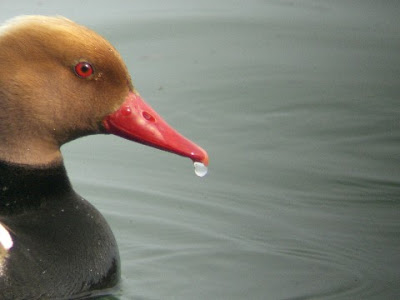 As soon as we got there, I was off with my binnies to see what I could see. Tons of Blackheaded Gulls (Larus ridibundus Lachmöwe) feeding and relaxing just off shore, with a few of the much larger Yellowlegged Gulls (Larus michahellis Mittelmeermöwe) hanging around. Not a single wader running along the pebbled shore, but a single pair of Dabchick (Little Grebe) and a couple of Great Crested Grebe pairs certainly made up for that.
As soon as we got there, I was off with my binnies to see what I could see. Tons of Blackheaded Gulls (Larus ridibundus Lachmöwe) feeding and relaxing just off shore, with a few of the much larger Yellowlegged Gulls (Larus michahellis Mittelmeermöwe) hanging around. Not a single wader running along the pebbled shore, but a single pair of Dabchick (Little Grebe) and a couple of Great Crested Grebe pairs certainly made up for that.I eagerly headed over to the forest. But it seemed like the only birds I saw were these annoyingly fleeting glimpses of fleeing birds. It seems that centuries of hunting birds (even the littlest of passerines) has left them with a well-developed fear of humans and I had to become very creative just to get a look at a bird through my binoculars (as a side note, I found six different shot gun cartridges in the forest). Eventually I learnt to sneak quietly through the forest and look for birds in the distance, and through gaps in the trees. If I saw them early enough then I generally got a decent look. At this stage you might be wondering why I did not just listen to them and identify them by call. I wish I were that good (I am trying to learn them though, I promise).
 Through stealth and persistence, I managed to find some nice birds. I found the Sardinian Warbler (Sylvia melanocephala Samtkopf-Grasmücke) to be fairly widespread and common, but incredibly shy. A lot shyer than the very vocal Blackcap (Mönchsgrasmücke). The best way to find the Sardinian Warblers (as with all the other warblers) was definitely by call, and in the late afternoon, there were often a good half a dozen singing from the tops of the trees/bushes along La Rocca's higher savanna-like ridges.
Through stealth and persistence, I managed to find some nice birds. I found the Sardinian Warbler (Sylvia melanocephala Samtkopf-Grasmücke) to be fairly widespread and common, but incredibly shy. A lot shyer than the very vocal Blackcap (Mönchsgrasmücke). The best way to find the Sardinian Warblers (as with all the other warblers) was definitely by call, and in the late afternoon, there were often a good half a dozen singing from the tops of the trees/bushes along La Rocca's higher savanna-like ridges. The late afternoons were also a good time to look out for the wing feeders. Barn Swallows (Rauchschwalbe) and Crag Martins (Felsenschwalbe) would buzz the open fields and cliff edges, and House Martins (Mehlschwalbe) would feed over village edges. Apparently, the Common Swift (Apus apus Mauersegler) traditionally gets back to Austria on 1 May each year, so I was on the lookout for them. 1 May came and not a single Black Swift (but a good few Alpine Swifts!). But the morning of 2 May, suddenly they were about. A brisk wind was blowing up off of the lake, and lifting up against the lake-side cliffs; much to the delight of the 30-odd common and alpine swifts gathered there. I swear they were playing. So graceful. So incredible.
The late afternoons were also a good time to look out for the wing feeders. Barn Swallows (Rauchschwalbe) and Crag Martins (Felsenschwalbe) would buzz the open fields and cliff edges, and House Martins (Mehlschwalbe) would feed over village edges. Apparently, the Common Swift (Apus apus Mauersegler) traditionally gets back to Austria on 1 May each year, so I was on the lookout for them. 1 May came and not a single Black Swift (but a good few Alpine Swifts!). But the morning of 2 May, suddenly they were about. A brisk wind was blowing up off of the lake, and lifting up against the lake-side cliffs; much to the delight of the 30-odd common and alpine swifts gathered there. I swear they were playing. So graceful. So incredible.The mixed scrub, forest and fields, also yielded a few pairs of Nightingales (Nachtigal, click for map), a Pied Flycatcher (Trauerschnäpper, click for map), a Grey Partridge (Rebhuhn), and dramatic vistas across the lake. Walking back through the fringe farmlands, I found a couple of pairs of Hoopoe (Wiedehopf, click for map of 2 locations) and lots of Hooded Crows (Nebelkrähe).
The little reed bed at San Biaggio (here) produced about 30 singing reed warblers (Teichrohrsänger), two sedge warblers (Schilfrohrsänger), a moorhen (Teichrallen) nest and some coots (Blässhuhn). I also picked up a Common Whitethroat (Dorngrasmücke) feeding on some berries in this same area. Whilst walking through the camping areas, also keep a look out for the almost ubiquitous Spotted Flycatchers (Grauschnäpper) and Serins (Girlitz).
 I took this photo of a Redcrested Pochard (Kolbenente) on the lake with my little casio digital camera held up to my swarovski SLR binoculars. I am quite happy with the result. Not perfectly sharp, but close.
I took this photo of a Redcrested Pochard (Kolbenente) on the lake with my little casio digital camera held up to my swarovski SLR binoculars. I am quite happy with the result. Not perfectly sharp, but close.So, it seems like there is at least something to keep the birder occupied around Lago di Garda. But before you go, brush up on those bird calls, and make sure you take your binoculars!









.jpg)








.jpg)




No comments:
Post a Comment